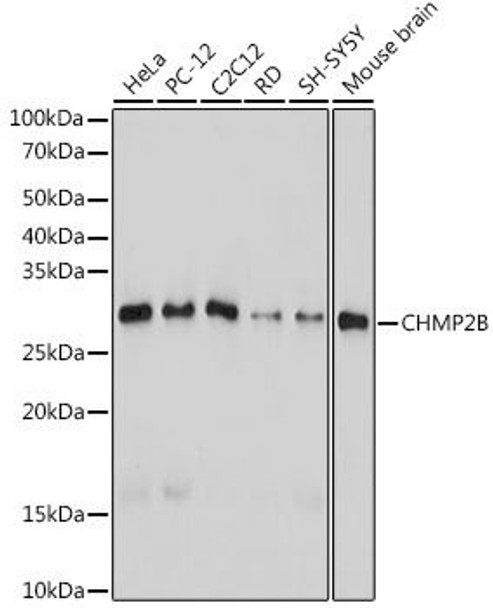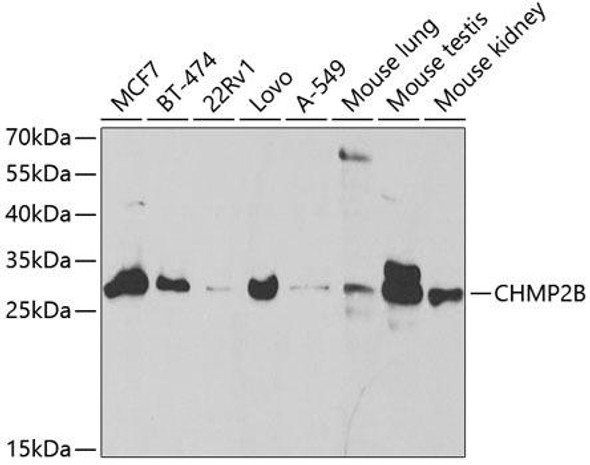Anti-CHMP2B Antibody (CAB19244)
- SKU:
- CAB19244
- Product Type:
- Antibody
- Antibody Type:
- Monoclonal Antibody
- Reactivity:
- Human
- Reactivity:
- Mouse
- Reactivity:
- Rat
- Host Species:
- Rabbit
- Isotype:
- IgG
- Synonyms:
- CHMP2B
- Synonyms:
- ALS17
- Synonyms:
- CHMP2.5
- Synonyms:
- DMT1
- Synonyms:
- VPS2-2
- Synonyms:
- VPS2B
- Synonyms:
- charged multivesicular body protein 2b
- Research Area:
- Cell Biology
Description
| Product Name: | CHMP2B Rabbit mAb |
| Product Code: | CAB19244 |
| Size: | 20uL, 50uL, 100uL |
| Synonyms: | CHMP2B, ALS17, CHMP2.5, DMT1, VPS2-2, VPS2B, charged multivesicular body protein 2b |
| Applications: | WB, IHC |
| Reactivity: | Human, Mouse, Rat |
| Host Species: | Rabbit |
| Immunogen: | Recombinant protein of human CHMP2B. |
| Applications: | WB, IHC |
| Recommended Dilutions: | WB 1:500 - 1:2000 IHC 1:50 - 1:200 |
| Reactivity: | Human, Mouse, Rat |
| Positive Samples: | HeLa, PC-12, C2C12, RD, SH-SY5Y, Mouse brain |
| Immunogen: | Recombinant protein of human CHMP2B. |
| Purification Method: | Affinity purification |
| Storage: | Store at -20°C. Avoid freeze / thaw cycles. Buffer: PBS with 0.02% sodium azide, 50% glycerol, pH7.3. |
| Isotype: | IgG |
| Sequence: | Email for sequence |
| Gene ID: | 25978 |
| Uniprot: | Q9UQN3 |
| Cellular Location: | Cytoplasm, Late endosome membrane, Peripheral membrane protein, cytosol |
| Calculated MW: | 28kDa |
| Observed MW: | 28KDa |
| UniProt Protein Function: | CHMP2B: Probable core component of the endosomal sorting required for transport complex III (ESCRT-III) which is involved in multivesicular bodies (MVBs) formation and sorting of endosomal cargo proteins into MVBs. MVBs contain intraluminal vesicles (ILVs) that are generated by invagination and scission from the limiting membrane of the endosome and mostly are delivered to lysosomes enabling degradation of membrane proteins, such as stimulated growth factor receptors, lysosomal enzymes and lipids. The MVB pathway appears to require the sequential function of ESCRT-O, -I,-II and -III complexes. ESCRT-III proteins mostly dissociate from the invaginating membrane before the ILV is released. The ESCRT machinery also functions in topologically equivalent membrane fission events, such as the terminal stages of cytokinesis and the budding of enveloped viruses (HIV-1 and other lentiviruses). ESCRT-III proteins are believed to mediate the necessary vesicle extrusion and/or membrane fission activities, possibly in conjunction with the AAA ATPase VPS4. Defects in CHMP2B are the cause of frontotemporal dementia, chromosome 3-linked (FTD3). FTD3 is characterized by an onset of dementia in the late 50's initially characterized by behavioral and personality changes including apathy, restlessness, disinhibition and hyperorality, progressing to stereotyped behaviors, non-fluent aphasia, mutism and dystonia, with a marked lack of insight. The brains of individuals with FTD3 have no distinctive neuropathological features. They show global cortical and central atrophy, but no beta-amyloid deposits. Defects in CHMP2B are the cause of amyotrophic lateral sclerosis type 17 (ALS17). An adult-onset progressive neurodegenerative disorder with predominantly lower motor neuron involvement, manifest as muscle weakness and wasting of the upper and lower limbs, bulbar signs, and respiratory insufficiency. Belongs to the SNF7 family. |
| UniProt Protein Details: | Chromosomal Location of Human Ortholog: 3p11.2 Cellular Component: nucleoplasm; mitochondrion; late endosome membrane; lysosome; late endosome; cytoplasm; plasma membrane; intracellular; cytosol; nucleus; endosome Molecular Function:protein domain specific binding; protein binding Biological Process: protein transport; viral reproduction; endosome organization and biogenesis; cell separation during cytokinesis; vacuolar transport; viral infectious cycle; cognition; endosome transport; mitotic metaphase plate congression; nuclear organization and biogenesis Disease: Frontotemporal Dementia, Chromosome 3-linked; Amyotrophic Lateral Sclerosis 17 |
| NCBI Summary: | This gene encodes a component of the heteromeric ESCRT-III complex (Endosomal Sorting Complex Required for Transport III) that functions in the recycling or degradation of cell surface receptors. ESCRT-III functions in the concentration and invagination of ubiquitinated endosomal cargos into intralumenal vesicles. The protein encoded by this gene is found as a monomer in the cytosol or as an oligomer in ESCRT-III complexes on endosomal membranes. It is expressed in neurons of all major regions of the brain. Mutations in this gene result in one form of familial frontotemporal lobar degeneration. [provided by RefSeq, Jul 2008] |
| UniProt Code: | Q9UQN3 |
| NCBI GenInfo Identifier: | 73917746 |
| NCBI Gene ID: | 25978 |
| NCBI Accession: | Q9UQN3.1 |
| UniProt Secondary Accession: | Q9UQN3,Q53HC7, Q9Y4U6, B4DJG8, |
| UniProt Related Accession: | Q9UQN3 |
| Molecular Weight: | 213 |
| NCBI Full Name: | Charged multivesicular body protein 2b |
| NCBI Synonym Full Names: | charged multivesicular body protein 2B |
| NCBI Official Symbol: | CHMP2B |
| NCBI Official Synonym Symbols: | DMT1; ALS17; VPS2B; VPS2-2; CHMP2.5 |
| NCBI Protein Information: | charged multivesicular body protein 2b; VPS2 homolog B; chromatin modifying protein 2B; vacuolar protein-sorting-associated protein 2-2 |
| UniProt Protein Name: | Charged multivesicular body protein 2b |
| UniProt Synonym Protein Names: | CHMP2.5; Chromatin-modifying protein 2b; CHMP2b; Vacuolar protein sorting-associated protein 2-2; Vps2-2; hVps2-2 |
| Protein Family: | Charged multivesicular body protein |
| UniProt Gene Name: | CHMP2B |
| UniProt Entry Name: | CHM2B_HUMAN |






